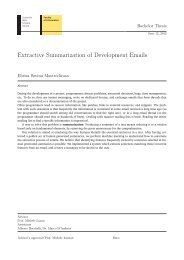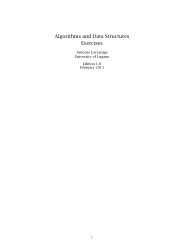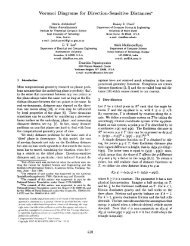Barycentric coordinates and transfinite interpolation
Barycentric coordinates and transfinite interpolation
Barycentric coordinates and transfinite interpolation
You also want an ePaper? Increase the reach of your titles
YUMPU automatically turns print PDFs into web optimized ePapers that Google loves.
<strong>Barycentric</strong> <strong>coordinates</strong> <strong>and</strong> <strong>transfinite</strong><br />
<strong>interpolation</strong><br />
Michael Floater<br />
Centre of Mathematics for Applications,<br />
Department of Informatics,<br />
University of Oslo
In this talk:<br />
1. <strong>Barycentric</strong> <strong>coordinates</strong><br />
2. Generalization to polygons: Wachspress, mean value, etc.<br />
3. Transfinite <strong>interpolation</strong>
<strong>Barycentric</strong> <strong>coordinates</strong> on a triangle<br />
v 3<br />
T<br />
x<br />
v 1<br />
v 2<br />
Given x ∈ T , want λ 1 , λ 2 , λ 3 ≥ 0 such that<br />
λ 1 + λ 2 + λ 3 = 1,<br />
<strong>and</strong><br />
λ 1 v 1 + λ 2 v 2 + λ 3 v 3 = x.
Linear system of three equations,<br />
⎛ ⎞ ⎛ ⎞ ⎛ ⎞<br />
1 1 1 λ 1 1<br />
⎝v1 1 v2 1 v3<br />
1 ⎠ ⎝λ 2<br />
⎠ = ⎝x 1 ⎠ .<br />
v1 2 v2 2 v3<br />
2 λ 3 x 2<br />
By Cramer’s rule, unique solution is<br />
λ 1 = A 1<br />
A , λ 2 = A 2<br />
A , λ 3 = A 3<br />
A .<br />
v 3<br />
A<br />
A 2<br />
x<br />
A 3<br />
A 1<br />
v 1<br />
v 2
Properties<br />
◮ Lagrange property: λ i (v j ) = δ ij .<br />
◮ Interpolation: if<br />
g(x) =<br />
3∑<br />
λ i (x)f (v i ),<br />
i=1<br />
then g(v i ) = f (v i ).<br />
◮ Linear precision: if f is linear then g = f .<br />
◮ Linearity: λ i is linear.<br />
◮ Bernstein-Bezier basis for polynomials, degree d:<br />
p(x) =<br />
∑<br />
i+j+k=d<br />
n!<br />
i!j!k! λi 1(x)λ j 2 (x)λk 3(x)c ijk .
<strong>Barycentric</strong> <strong>coordinates</strong> on polygons<br />
Let Ω be a convex polygon.<br />
v 4<br />
v 3<br />
v 5<br />
v 1 v 2<br />
Functions λ i : Ω → R, i = 1, . . . , n, are barycentric <strong>coordinates</strong> if<br />
for x ∈ Ω, λ i (x) ≥ 0, i = 1, . . . , n, <strong>and</strong><br />
n∑<br />
λ i (x) = 1,<br />
i=1<br />
n∑<br />
λ i (x)v i = x.<br />
i=1
Properties<br />
◮ Lagrange property: λ i (v j ) = δ ij .<br />
◮ Interpolation: if<br />
n∑<br />
g(x) = λ i (x)f (v i ),<br />
i=1<br />
then g(v i ) = f (v i ).<br />
◮ Linear precision: if f is linear then g = f .<br />
◮ λ i lies between the two functions:<br />
1<br />
1<br />
0<br />
0<br />
0<br />
0<br />
0<br />
0<br />
◮ Generalized Bernstein-Bezier:<br />
p(x) = ∑ ( ) d<br />
λ i 1<br />
i 1<br />
(x) · · · λ in n (x)c i .<br />
|i|=d<br />
0<br />
0<br />
0<br />
0
Coordinates for quadrilaterals<br />
v 01<br />
v 11<br />
x<br />
v 00<br />
v 10<br />
Can find λ, µ ∈ [0, 1] s.t.<br />
x = (1 − λ)(1 − µ)v 00 + λ(1 − µ)v 10 + (1 − λ)µv 01 + λµv 11 ,<br />
giving an interpolant<br />
g(x) = (1 − λ)(1 − µ)f 00 + λ(1 − µ)f 10 + (1 − λ)µf 01 + λµf 11 .
To find λ <strong>and</strong> µ: let<br />
a = v 00 −x, b = v 10 −v 00 , c = v 01 −v 00 , d = v 00 −v 10 −v 01 +v 11 .<br />
Then need to solve<br />
a + bλ + cµ + dλµ = 0.<br />
Eliminating λ gives a quadratic in µ:<br />
(a + cµ) × (b + dµ) = 0.<br />
Similar for λ. The special cases c × d = 0 <strong>and</strong> b × d = 0 need to<br />
be treated separately.
Wachspress <strong>coordinates</strong>: Wachspress 1973, Warren 1996<br />
v i+1<br />
x<br />
v i<br />
v i−1<br />
For a convex polygon, n vertices, let<br />
λ i (x) =<br />
w i (x)<br />
∑ n<br />
j=1 w j(x) , w i(x) =<br />
Then λ 1 , . . . , λ n are barycentric <strong>coordinates</strong>.<br />
A(v i−1 , v i , v i+1 )<br />
A(x, v i−1 , v i )A(x, v i , v i+1 ) .
Proof: Meyer et al. 2002<br />
Let<br />
A i = A(x, v i , v i+1 ) <strong>and</strong> B i = A(v i−1 , v i , v i+1 ).<br />
Then express x as<br />
<strong>and</strong> rearrange:<br />
x = A i<br />
v i−1 + (B i − A i−1 − A i )<br />
v i + A i−1<br />
v i+1 ,<br />
B i B i<br />
B i<br />
B i<br />
(v i − x) = 1 (v i − v i−1 ) − 1 (v i+1 − v i ).<br />
A i−1 A i A i−1 A i<br />
Summing both sides over i gives<br />
∑ B i<br />
(v i − x) = 0<br />
A i−1 A i<br />
or<br />
i<br />
∑<br />
w i (x)(v i − x) = 0.<br />
i
Wachspress <strong>coordinates</strong> are rational<br />
λ i (x) =<br />
B i<br />
∑<br />
k B k<br />
∏<br />
j≠i−1,i A j(x)<br />
∏<br />
j≠k−1,k A j(x)<br />
=<br />
degree (n − 2)<br />
degree (n − 3) .
Application: barycentric mappings<br />
Recipe: given x ∈ Ω,<br />
1. express x in Wachspress form x = ∑ i λ i(x)v i ,<br />
2. set x ′ = ∑ i λ i(x)v ′ i .
Application: curve deformation
Theorem (F. & Kosinka). Wachspress mappings are injective<br />
Idea of proof: express Jacobian as<br />
∣<br />
∑<br />
λ i λ j λ k ∣∣∣∣∣<br />
J = 2<br />
∂ 1 λ i ∂ 1 λ j ∂ 1 λ k A(v i, ′ v j, ′ v k ′<br />
1≤i
Mean value <strong>coordinates</strong><br />
v i+1<br />
v i<br />
x<br />
α i<br />
α i−1<br />
v i−1<br />
For a convex polygon, n vertices, let λ i (x) = w i (x)/ ∑ n<br />
j=1 w j(x),<br />
where<br />
w i (x) =<br />
(<br />
1<br />
tan<br />
‖v i − x‖<br />
(<br />
αi−1 (x)<br />
2<br />
)<br />
+ tan<br />
Then λ 1 , . . . , λ n are barycentric <strong>coordinates</strong>.<br />
(<br />
αi (x)<br />
2<br />
))<br />
.
Proof:<br />
With e i = (v i − x)/‖v i − x‖, need to show that<br />
or<br />
n∑ (<br />
tan(αi−1 /2) + tan(α i /2) ) e i = 0,<br />
i=1<br />
n∑<br />
tan(α i /2)(e i + e i+1 ) = 0. (1)<br />
i=1<br />
To show this, let e i = (cos θ i , sin θ i ). Then α i = θ i+1 − θ i , <strong>and</strong> so<br />
( αi<br />
)<br />
( αi<br />
)<br />
tan (e i + e i+1 ) = tan (cos θ i + cos θ i+1 , sin θ i + sin θ i+1 )<br />
2<br />
2<br />
= (sin θ i+1 − sin θ i , cos θ i − cos θ i+1 ).<br />
Summing this over i = 1, . . . , n gives (1).
Application: mesh parameterization
Transfinite <strong>interpolation</strong>, Warren et al 2004<br />
c ( t i+1 )<br />
c ( t i)<br />
For convex curve c : [a, b] → R 2 sample points v i = c(t i ) <strong>and</strong> take<br />
limit of Wachspress interpolants as max i (t i+1 − t i ) → 0. Gives a<br />
‘<strong>transfinite</strong> interpolant’<br />
∫ /<br />
b<br />
∫ b<br />
g(x) = w(x, t)f (c(t)) dt w(x, t) dt,<br />
a<br />
where w(x, t) = (c ′ (t) × c ′′ (t))/((c(t) − x) × c ′ (t)) 2 .<br />
a
MV <strong>transfinite</strong> <strong>interpolation</strong><br />
c ( t i+1 )<br />
c ( t i)<br />
Analogously, the <strong>transfinite</strong> MV interpolant is<br />
∫ /<br />
b<br />
∫ b<br />
g(x) = w(x, t)f (c(t)) dt w(x, t) dt,<br />
a<br />
a<br />
where<br />
w(x, t) = (c(t) − x) × c′ (t)<br />
‖c(t) − x‖ 3 .
Examples of MV interpolants
Non-convex curves? Angle formulation<br />
p ( x, θ)<br />
x<br />
θ<br />
For a convex curve, the MV interpolant is<br />
g(x) =<br />
∫ 2π<br />
0<br />
/ ∫<br />
f (p(x, θ))<br />
2π<br />
‖p(x, θ) − x‖ dθ 1<br />
‖p(x, θ) − x‖ dθ.<br />
0
On arbitrary curves<br />
p ( x, θ)<br />
2<br />
p 3<br />
( x, θ)<br />
p 1<br />
( x, θ)<br />
x<br />
θ<br />
where<br />
g(x) =<br />
∫ 2π<br />
0<br />
n(x,θ)<br />
∑<br />
j=1<br />
φ(x) =<br />
Hormann: φ(x) > 0.<br />
/<br />
(−1) j−1<br />
‖p j (x, θ) − x‖ f (p j(x, θ)) dθ φ(x),<br />
∫ 2π<br />
0<br />
n(x,θ)<br />
∑<br />
j=1<br />
(−1) j−1<br />
‖p j (x, θ) − x‖ dθ.
Application: image warping, Hormann
Application: mesh deformation, Ju, Schaefer, Warren
Hermite <strong>interpolation</strong><br />
Two methods:<br />
◮ Use MV weight function (with Chris Dyken / Solveig Bruvoll)<br />
◮ Radial minimization (with Christian Schulz)
Method 1: weight function<br />
The cubic interpolant p to the data f (0), f ′ (0), f (1), f ′ (1), can be<br />
expressed as<br />
p(x) = g 0 (x) + ψ(x)g 1 (x),<br />
where<br />
g 0 (x) = (1 − x)f (0) + xf (1),<br />
ψ(x) = x(1 − x),<br />
g 1 (x) = (1 − x)m 0 + xm 1 ,<br />
<strong>and</strong><br />
m 0 = f ′ (0) − f (1) + f (0), m 1 = −f ′ (1) + f (1) − f (0).
In R n we interpolate the data f <strong>and</strong> ∂f<br />
∂n<br />
on ∂Ω by the function<br />
p(x) = g 0 (x) + ψ(x)g 1 (x), x ∈ Ω,<br />
where<br />
<strong>and</strong><br />
m(y) =<br />
∫<br />
/<br />
f (p(x, v))<br />
g 0 (x) =<br />
S ‖p(x, v) − x‖ dv φ(x),<br />
/<br />
ψ(x) = 1 φ(x),<br />
∫<br />
g 1 (x) =<br />
S<br />
/<br />
m(p(x, v))<br />
‖p(x, v) − x‖ dv φ(x),<br />
∫<br />
φ(x) =<br />
1<br />
‖p(x, v) − x‖ dv.<br />
S<br />
( ∂f<br />
∂n (y) − ∂g 0<br />
∂n (y) ) / ∂ψ<br />
∂n (y),<br />
y ∈ ∂Ω.
To use this construction we need to find ∂ψ<br />
∂n (y) <strong>and</strong> ∂g 0<br />
∂n (y).<br />
Theorem<br />
If d(M E , ∂Ω) > 0 <strong>and</strong> d(M I , ∂Ω) > 0 <strong>and</strong> y ∈ ∂Ω then<br />
∂ψ<br />
∂n (y) = 1 ,<br />
V n−1<br />
∂g 0<br />
∂n (y) = 1 f (p(y, v)) − f (y)<br />
V n−1<br />
∫H(n) ‖p(y, v) − y‖<br />
dv,<br />
where V n−1 is the volume of the unit sphere in R n−1 : V 1 = 2,<br />
V 2 = π, V 3 = 4π/3, V 4 = π 2 /2,...
Hermite examples
Method 2: radial minimization<br />
MV <strong>interpolation</strong> revisited: the value g(x) is the unique minimizer<br />
a = g(x) of the local ‘energy’ function<br />
where<br />
∫<br />
E x (a) =<br />
q x,v (r) =<br />
<strong>and</strong> ρ(x, v) = ‖p(x, v) − x‖.<br />
S<br />
∫ ρ(x,v)<br />
0<br />
(<br />
q<br />
′<br />
x,v (r) ) 2 dr dv,<br />
ρ(x, v) − r<br />
a +<br />
r f (p(x, v)),<br />
ρ(x, v) ρ(x, v)
Hermite <strong>interpolation</strong><br />
Find a ∈ R <strong>and</strong> b ∈ R n that minimize<br />
∫ ∫ ρ(x,v) (<br />
E x (a, b) =<br />
q<br />
′′<br />
x,v(r) ) 2 dr dv,<br />
where q x,v is the cubic polynomial such that<br />
S<br />
0<br />
q x,v (0) = a,<br />
q ′ x,v(0) = v · b,<br />
q x,v (ρ(x, v)) = f (p(x, v)),<br />
q ′ x,v(ρ(x, v)) = D v f (p(x, v)),<br />
<strong>and</strong> set g(x) = a.<br />
Has cubic precision!
Example of radial minimization
Comparison of the two Hermite methods<br />
Radial cosine Method 1 Method 2
















